|
|
|
Sort Order |
|
|
|
Items / Page
|
|
|
|
|
|
|
| Srl | Item |
| 1 |
ID:
174922
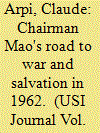

|
|
|
| 2 |
ID:
174936
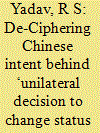

|
|
|
|
|
| Summary/Abstract |
Ever since 05 May 2020, when the Pangong Tso fracas became public, there has been an unending cacophony of news, views, critiques and suggestions. But after the loss of 20 Brave Hearts at Galwan, on the night 15/16 Jun, the Indian blood has been on the boil ! Recommendations spanning from hard-core punitive military action to soft diplomatic resolution have come forth from the academia and strategists. The Indian Government has since banned numerous Chinese apps, and imposed various economic checks, and the common public too has swung into action to shun everything Chinese. But, from what is gradually emerging, the recent intrusions and face offs, backed up by heavy force levels, are pre-meditated, deliberate, People’s Liberation Army (PLA) military actions — with a definite aim. It would, therefore, be prudent that instead of knee-jerk response(s), the ‘Chinese Intent’ be first ascertained / deduced with sufficient clarity to tailor-make a response which not only thwarts its immediate military designs with minimal efforts but also obstructs its larger strategic goals. The article attempts to deduce the PLA’s immediate Military Aim(s) and Chinese Intent, and then suggests India’s military response and follow up strategy.
|
|
|
|
|
|
|
|
|
|
|
|
|
|
|
|
| 3 |
ID:
174923
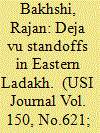

|
|
|
| 4 |
ID:
174941


|
|
|
|
|
| Summary/Abstract |
The ongoing standoff in Ladakh, which started in May 2020, has been the most serious so far in terms of casualties since the Cho La and Nathu La clashes of 1967. The incongruity of the soldiers of two nuclear weapon armed countries, inflicting casualties on each other without use of firearms, came in for much adverse comment. The commentators and the public would have been more informed had they been clear about the confidence building agreements signed between India and China regarding management of and conduct on the Line of Actual Control (LAC). This article gives out the important details of these agreements and provides links where the interested scholar can further research the subject.
|
|
|
|
|
|
|
|
|
|
|
|
|
|
|
|
| 5 |
ID:
174931


|
|
|
|
|
| Summary/Abstract |
Though the Indian Navy was not directly involved in the conflict of 1962, it had by then slowly created a significant surface force and had one aircraft carrier but was yet to induct submarines. The People’s Liberation Army Navy (PLAN), on the other hand, was primarily geared for coastal defence but had a growing fleet of submarines. The sole naval threat from the PLAN was the possibility of deployment of its submarines. Yet, on this anniversary of the 1962 war, it is clear that any future conflict with China will spread to the Indian Ocean through which the great trading power’s Sea Lines of Communication (SLOCs) traverse. These SLOCs are the potential targets and obviously require guarding. The growing Chinese naval presence in the Indian Ocean attests to that. This article attempts to put forth the maritime picture in 1962 so as to induce thinking on the Chinese maritime threat in the future.
|
|
|
|
|
|
|
|
|
|
|
|
|
|
|
|
| 6 |
ID:
174945


|
|
|
|
|
| Summary/Abstract |
For India the year 2020 will be remembered for Covid-19 and Chinese intrusions in Ladakh. However, such transgressions and intrusions have occurred in the past also. This personal narrative is about the establishment of a Post at the Bara Hoti plains region of India. The author gives an enthralling account of the race against time six months before the war broke out which enabled checkmating a Chinese move to seize an important grazing ground.
|
|
|
|
|
|
|
|
|
|
|
|
|
|
|
|
| 7 |
ID:
174929
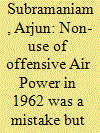

|
|
|
|
|
| Summary/Abstract |
The non-use of offensive air power in the India-China conflict of 1962 is among the most discussed issues in the contemporary India-China discourse. There was a complete lack of understanding on the part of the strategic establishment of what offensive air power could achieve in Ladakh and North-East Frontier Agency (NEFA). Compounding this was a lack of clarity within the Indian Army of the value addition provided by the Indian Air Force’s (IAF’s) fighter fleet and a diffident approach on the part of the IAF leadership to espouse the use of offensive air power. However, the sterling contribution of the IAF’s transport and helicopter fleet during the conflict merits a re-examination.
|
|
|
|
|
|
|
|
|
|
|
|
|
|
|
|
| 8 |
ID:
174926


|
|
|
|
|
| Summary/Abstract |
This article briefly recapitulates the 1962 war operations in the Kameng Sector to bring out the suggested manner in which operations should be conducted against the People’s Liberation Army (PLA), should a need arise in the present time. Such threat from the PLA is very real keeping in mind present tensions on the Line of Actual Control (LAC).
|
|
|
|
|
|
|
|
|
|
|
|
|
|
|
|
| 9 |
ID:
174927
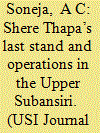

|
|
|
|
|
| Summary/Abstract |
Legends in the military are born in martyrdom and adversity. In the isolated and desolate spots where soldiers serve, the melancholy quiet and deepening shadows of late evenings create illusions which bring to life the spirits of dead warriors. Soon shrines get created at such places to honour them. If the shrine is on a road, passers-by stop and pay obeisance. If it is off the beaten track, the martyr’s memory lives on in local folklore. In Arunachal Pradesh, the first category is Rifleman (Rfn) Jaswant Singh of 4th Battalion, the Garhwal Rifles. In the second is Havildar Shere Thapa of 2nd Battalion, the Jammu & Kashmir Rifles. The author tells the latter’s story intertwined with operations in the upper Subansiri in November 1962.
|
|
|
|
|
|
|
|
|
|
|
|
|
|
|
|
| 10 |
ID:
174949


|
|
|
|
|
| Summary/Abstract |
Pyawbwe was captured in a three-brigade envelopment by 17 Indian Division. It was stoutly defended and after its capture some 1,110 Japanese dead and 13 guns were counted. The official history describes the fight as ‘the only large action in the Battle of the Rangoon Road’ and says that it ‘finally shattered [the Japanese] 33rd Army’. The Imperial War Museum, London is digitising their collection of World War II newsreels. Among those is one of 1 Sikh LI in action at Pyawbwe in Burma, on 11 April 1945, filmed by an Indian Public Relations cameraman, Lieutenant H Benjamin. A copy of the video, with the dope-sheet, is now with the USI. The video is muted so it does not have any background sounds or narrative, but it does give an insight to the Pyawbwe operations. This account covers the story of 1 Sikh Light Infantry (1 Sikh LI) and their earning the battle honour of Pyawbwe, in addition to other honours. The article aims to provide context to the battle.
|
|
|
|
|
|
|
|
|
|
|
|
|
|
|
|
| 11 |
ID:
174928
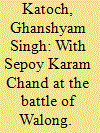

|
|
|
|
|
| Summary/Abstract |
In July 2010, the Border Road Task Force (BRTF), while working on road improvement near Walong, uncovered a grave with the remains of a jawan of 4 Dogra who had died in the 1962 war. The battle of Walong occurred in the second phase of the 1962 war during the offensive in the Lohit valley. A bitterly fought battle, it was the only one in which the Indian and Chinese casualties were comparable. Interspersed with some autobiographical fiction, this article gives the account of a part of the battle of Walong where the only counter attack of the 1962 war was launched and the only planned withdrawal took place.
|
|
|
|
|
|
|
|
|
|
|
|
|
|
|
|
|
|
|
|
|